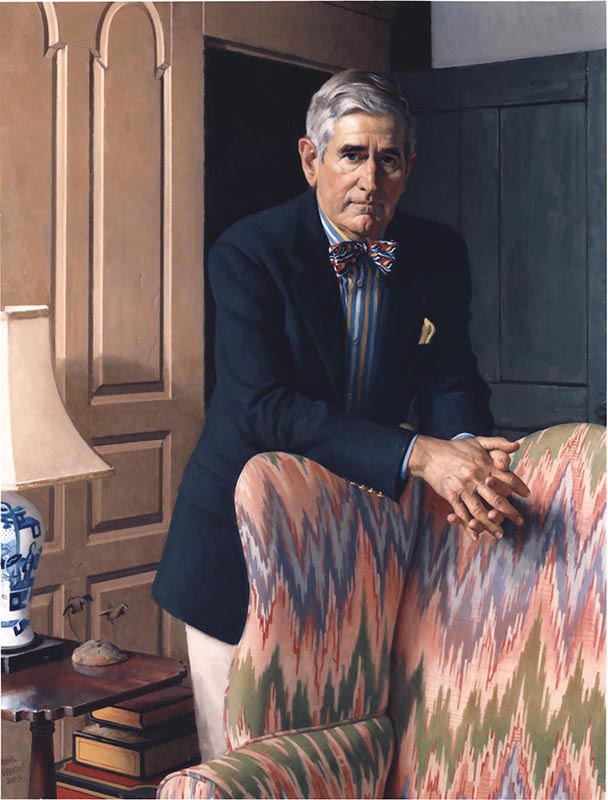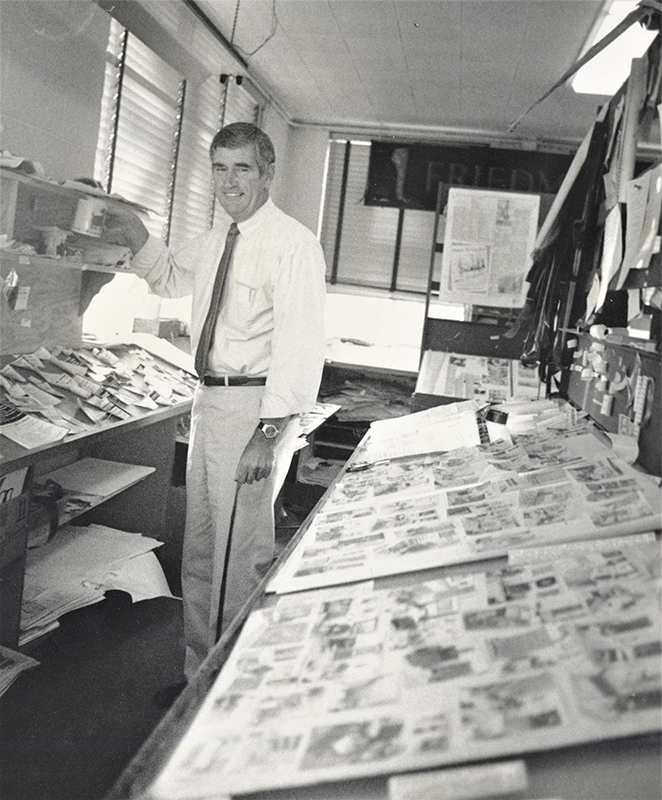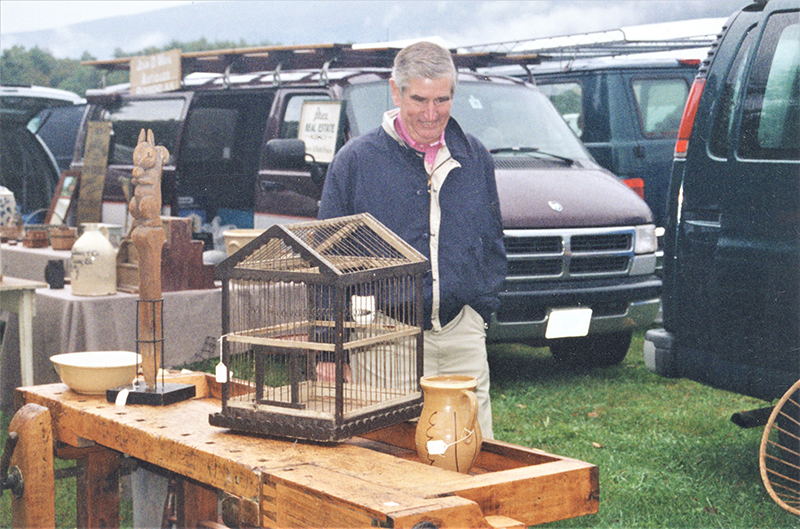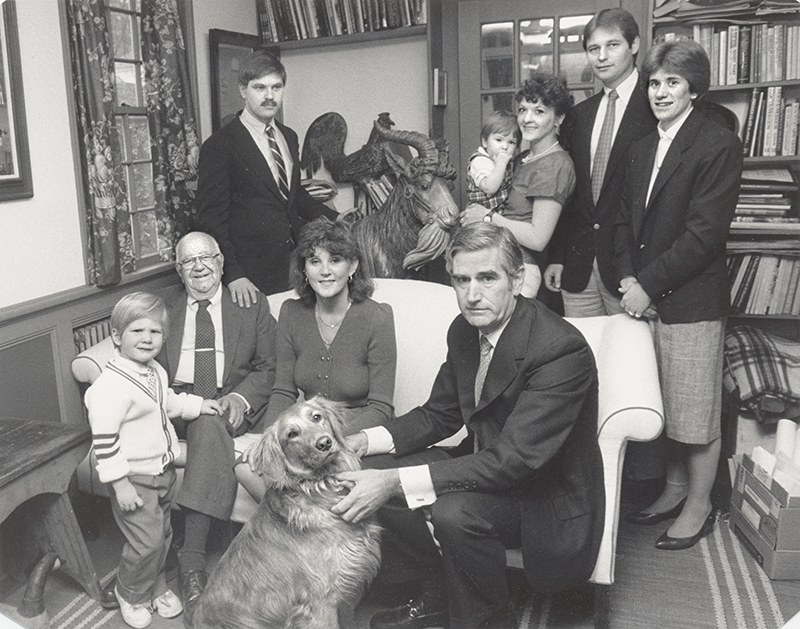
The influential publisher of the Newtown Bee newspaper and founder of its supplement, Antiques and the Arts Weekly, recently passed away at the age of 87. Our friends at the latter publication have graciously allowed us to excerpt their coverage. You can find their original articles here and here. Below those sections, you will find a personal remembrance of Scudder Smith, written for us by Kevin J. Tulimieri, a specialist at Nathan Liverant and Son Antiques.
R. Scudder Smith was a stylish, generous newspaperman with a light touch and winning sense of humor, who allowed his love of collecting and collectors to guide his editorial instincts, thereby influencing a generation of like-minded enthusiasts.
Many of us are where we are today because of Smith. Through the Newtown Bee, the newspaper he inherited from his forebears and published until his death, and Antiques and the Arts Weekly, the newspaper he launched as four editorial pages in the Bee in 1963, Smith befriended and promoted aspiring dealers, show managers, auctioneers, curators, and collectors. His persistent attention to their endeavors – the antiques shows and flea markets they directed and exhibited in, the auctions they organized and attended, the exhibitions they mounted and the books they published – created a framework for understanding the world of Americana and placed within it those whose careers and pastimes he followed.
Elegantly attired in Robert Graham shirts and bespoke bow ties to match, Smith was a dashing presence on the antiques trail. His style sense – he mixed strong color and sharp silhouettes with whimsy, and had a knack for stripping the starch out of the classics – expressed itself everywhere he was: at his home, a 1783 farmhouse that he and Helen, his wife of 66 years, filled to the rafters with their finds; in his gardens, which extended for acres and provided another excuse for collecting; and at the office, a romping mélange of trade signs, weathervanes, carousel figures and arcade devices that all but overwhelmed the setting’s more mundane purposes.

Beyond his undeniable flair and talent for friendship, Smith will be remembered for his fundamental decency. He moved easily in every social stratum and took pride in an old-fashioned approach to business that prized loyalty and thrift, values instilled in him by a family keenly attuned to and appreciative of community. It was community that Smith identified in the antiques trade and shared comprehensively with his readers, making Antiques and the Arts Weekly unlike any publication before it, with an informality and warmth that was all Smith’s own.
Born April 12, 1935, Robert Scudder Smith was the elder son of Paul Scudder Smith and Mary Starr Conger Smith, and older brother to Mary Starr Adams and Ted Smith. He captained the soccer and track teams at the Berkshire School in Sheffield, Mass., and entered Amherst College, his father’s alma mater, in 1953, later completing his studies at Union College in Schenectady, N.Y. It was during a stint in the US Marine Corps, where he trained as a navigator at Cherry Point, N.C., that he met the former Helen Willis, whom he married in 1956. A son, David, and daughter, Sherri, soon followed. The family returned to Newtown in 1961, when Smith formally joined The Bee Publishing Company.
Smith was 38 when he succeeded his father as The Bee’s editor and publisher. His first editorial on May 23, 1972, revealed his trademark humor and grace, qualities that served him well professionally. He might have been describing himself when he said of his father, “The door to his office has always been open to all comers and many post-editorial meetings have ended in complete accord.”
The region covered by the Bee was peppered with dealers and auctioneers. Though few of these early businesses survive, readers will remember the Ansonia, Conn., dealers George and Benjamin Arons, who advertised their annual antiques sales in the Bee in the 1930s; auctioneer O’Rundle Gilbert, whose notices appeared in the 1940s; and Carrell, whose shows and markets were listed by the early 1960s. From 1947 until the early 1960s, the Bee carried Thomas Ormsbee’s syndicated collecting column, “Know Your Heirlooms.”

Smith saw his editorial role as supportive, not adversarial. “Our goals for the antiques section, right from the start,” he explained at the time of the Bee’s centennial in 1977, “were to provide news in advance of an event, coverage when possible and a complete line of advertising. We have not limited ourselves to any one field, but go to glass shows as well as art shows, antique car rallies and the show and flea market circuit.”
After finishing his editorial chores each week on Thursday, Smith in the early years spent Fridays pounding on doors, talking to dealers and auctioneers, and selling ads for the next antiques section. One of his first initiatives was to produce a map, published July 31, 1963, listing 64 dealers in Western Connecticut, among them Howard K. Richmond, then at Silvermine Tavern in Norwalk; Florene Maine in Ridgefield; Thomas D. and Constance R. Williams in Litchfield; and Moira Wallace in Woodbury.
“From then on, people rapidly became aware of our antiques section, ad revenues started to climb and circulation went up. We repeated the maps each year, for many years,” he recalled. By the late 1960s, the names Harry Hartman, Nathan Liverant and Son, and Tillou Galleries, to name just three, regularly appeared in the Bee’s antiques pages, along with Lillian Cogan, I.M. Wiese, Avis and Rockwell Gardiner, Roger Bacon and John Walton. Withington, Bourne, Eldred and Skinner were mainstays of the Bee’s auction pages.
Scudder and Helen began dabbling in antiques as newlyweds. They tried their hands as recreational dealers, exhibited at weekend shows with an eye toward upgrading their growing Americana collection, and formed close friendships with two of the field’s most influential figures, the show promoter Russell Carrell (circa 1910-1998) and Mary Allis (1899-1987), a top dealer in American folk art. Never one to mince words, Allis urged the Smiths to refine their holdings and stop moonlighting as dealers. As their taste developed, the couple gravitated to folk sculpture. The first weathervane they purchased was a $75 sheet iron horse. They emptied the contents of their change jar, then borrowed the balance from Scudder’s father to acquire the piece.

Smith never tired of collecting. His house nearly full and garden complete, he, over the past two decades, turned his attention to antique American cast iron still banks, which replicated in miniature some of the humor and sculptural verve that first drew him to weathervanes. His new pursuit meant more travel – to toy and banks shows, auctions and conventions – and a new circle of friends. The Smiths transformed a former den into a dedicated space for showing Scudder’s banks, roughly 1,600 in all and dazzling in their variety.
Smith’s final antiquarian chase was in an online auction of antique banks this August. “We watched the auction from start to finish on my laptop, reporting his purchases to him and relaying hammer prices. He bought his last seven banks from a bed in Norwalk Hospital. Honestly, it was a bit frustrating. He wanted to bid on so many more, but he already owned them,” his daughter Sherri recounted.
Smith could not have accomplished a fraction of what he did without the loving support of his family. His wife, children, grandchildren, and great-grandchildren were a constant presence in his life, caring for him as he declined and until the very end making it possible for him to remain engaged in what he held most dear.
Sadness at the passing of R. Scudder Smith is tempered by our vivid memories of this great and good man. Through sheer force of imagination and with ample charm, he created a rich, colorful world in which we all shared. As Woodbury, Conn., dealer David Schorsch recently remarked, “For those of us who experienced those exiting halcyon days, we are all blessed with a lifetime of memories of Scudder and his remarkable circle of friends in the antiques business. Their spirits live on in a business and field of collecting they lovingly fostered and brought about for the rest of us to carry on.”
Testimonials
Compiled by Madelia Hickman Ring
By the time I met him in the early 1980s, Scudder Smith had become well known to collectors, dealers, curators and other inhabitants of the American antiques and art world through his Antiques and the Arts Weekly. This was the first-ever publication of its kind, begun in 1963 in Newtown, Conn., and devoted to coverage of upcoming antiques and art events from Maine to Pennsylvania and beyond.
Antiques enthusiasts of the 1940s, 1950s and early 1960s, participants in the post-World War II surge of interest in all things American, operated on the hit-or-miss basis of searching for antiques in the shops and at the auctions they just happened to know about. Scudder, as a collector himself, recognized the need for a comprehensive source of information on where – and when – to find art and antiques. It was an idea whose time had come.
Scudder from the beginning recognized the importance of involving dealers in his new enterprise – as advertisers, subscribers and contributors – and many readers felt that advertisements were as essential as show and exhibition listings. Buyers as well as sellers benefited from advertising: one collector told an interviewer that he had acquired rare and important additions to his toy-train collection by placing two full-page ads in Antiques and The Arts Weekly.
I hadn’t thought of comparing Scudder with Homer Eaton Keyes, founding editor of The Magazine ANTIQUES, until Laura Beach asked me to reflect on Scudder’s place in the American antiques and art world. It then occurred to me that Scudder had created, as Keyes had, a publication that became a major component of the development and growth of that world. Scudder’s focus was on the marketplace – on bringing buyers and sellers together. Keyes, too, understood the importance of cultivating dealers, attending auctions and reporting his findings, but his chief focus was on digging out and presenting new scholarly information. The two publications complemented one another admirably.
Scudder Smith and Homer Eaton Keyes were alike in loving “the stuff” and in being collectors of it – Keyes of Chinese export porcelain and Scudder of folk art. And both men brought passion and commitment to the tasks of shaping and editing their publications – each of which became the Bible in its domain.
Elizabeth Stillinger, author of The Antiquers and A Kind of Archeology: Collecting American Folk Art, 1876-1976
In founding Antiques and the Arts Weekly nearly 60 years ago, Scudder Smith became one of greatest boosters of the antiques business in the United States. Long before the ease of internet browsing, his weekly paper became a portal into the world of American antiques. The eagerly anticipated weekly advertisements for shows, tag sales and auctions became the beating heart of a rapidly growing marketplace. The paper brought together a community of collectors, dealers, auctioneers, museum professionals, scholars and enthusiasts with Scudder at its center, a gentlemanly and kind-hearted fatherly figure. His modest personal demeanor masked a professional who set a high bar in standards of journalistic integrity, class and fairness with a measure of old-fashioned New England charm. Scudder was a very loyal person who unhesitatingly stood by his friends and always preferred to see the best in people. One of my fondest early memories as a dealer involved Scudder and Helen Smith. About 1979, when I was in the ninth grade at Rye Country Day School and still a part-time dealer, I was exhibiting at the “Danbury Dealers Show,” an innovative and successful series of one-day events organized by Jackie Sideli. The highlight of my offerings that day was a wonderful Nineteenth Century paint-decorated sheet iron horse weathervane that I had discovered on a carriage house belonging to a family friend who was thrilled by an unexpected windfall from its sale to me. As a teenager I was incredibly honored when such highly esteemed collectors as Scudder and Helen Smith purchased that vane from me for $1,900, a large sum in those days, and my highest priced sale of the day. For those of us who experienced those exiting halcyon days, we are all blessed with a lifetime of memories of Scudder and his remarkable circle of friends in the antiques business. For me a torrent of names come to mind that must include Mary Allis, Avis and Rocky Gardiner, Stewart Gregory, Russell Carrell and his “family” of dealers, the Tillous, Guthmans, Bisnoffs, and so many others whose spirit live on in a business and field of collecting they lovingly fostered and brought about for the rest of us to carry on.
David A. Schorsch, dealer
Scudder Smith had a passion for bow ties, great American Folk Art and the latest discovery in the art world. A fixture at shows and auctions – with his camera at the ready – he was a benevolent newsman whose grace and dignity earned the love and respect of all. We will all miss him dearly.
John Hays, auction house specialist
I met Scudder when I joined my dad 51 years ago; we were always a supporter of Scudder. He was always so easy to work with. He didn’t guess at what the story was about, he wanted to get the facts. There wasn’t anything controversial about what he wrote. He was a gentleman whether walking around or in what he wrote.
When we founded the ADA (Antiques Dealers Association of America), he was very supportive and helped us in whatever way he could. And he was quite supportive of the ADA Award of Merit, which we started 22 years ago. We felt he so embodied the mission statement of what the award was about that we gave it to him (in 2006). He contributed in so many ways to our industry and our field; for a long time, he’s been a column that has supported the industry. He saw the whole bell curve of the entire Americana field; he saw it rise and he saw it get soft but he never lost his enthusiasm.
About 15 years ago, I was offered a booth at the Winter Antiques Show and was considering if it would be wise to do it. I asked several people I trusted and I called Scudder. He was very enthusiastic that we do it and I’ve no regrets that we did it.
I’ll miss his ties. One day, I went to his house for a meeting, and he said we could walk around. In one room, I could see his bow ties hanging on the inside of a door. I had to go over and take one, so I took the most outrageously garish tie and I put it on. Now, I can wear some pretty loud ties, but mine were wimpy compared to his. I went downstairs wearing his tie; he noticed right away and gave me a lot of grief about it.
Arthur Liverant, dealer
He had such a wonderful eye and was such an enormous force. He was so welcoming and kind to me and Mike; he always had our back as trustees of the American Folk Art Museum. He was serious without being heavy, he had a twinkle and was a great combination of knowledge and kindness.
Lucy Danziger, collector and museum patron
I first met Scudder in 1973, when he and Charles Montgomery were working together to produce a special issue of the Bee to feature the new installation of American Arts and the American Experience at Yale. We used to refer to it as “The Tabloid.” I always thought it was such an inspired idea of Scudder’s. He was a master at communicating what was happening in the scholarly and commercial world devoted to art and antiques. I remember him running around at antiques shows, camera in hand, really recording what was going on. Going through the pages of the paper, I would think, “he goes everywhere!” He brought the whole world of what was going on the antiques world to your door, every week.
Patricia Kane, Yale University
I have so many memories, they’re overwhelming. We met the first time we ever did one of Russell Carrell’s indoor shows. He was sitting with the dealer next to us and she was distressed, and he was so patient and sat and listened to her. I had no idea who he was, but I thought he was the nicest man to listen to her. He spent a lot of time with me, directing me on how to be a show manager. I learned so much from him, he had such experience. He always had suggestions on how I could do things better; most were valid and I tried to adopt a lot of them.
Karen DiSaia, show promoter
Scudder and Helen have been fixtures at antiques shows across the country for the 46 years we have been in business. Scudder was dedicated to the best interest of the dealer through his coverage of the shows and auctions with unrivaled enthusiasm. He had the collector sensitivity and love of Americana both in his personal life and through his press. A most memorable day occurred when he opened his house to the Antiques Dealers’ Association, and we were free to roam among his prized possessions, gardens and general store. Scudder’s passing is a major loss to the many dealers he helped to elevate by his coverage of countless shows.
Patrick Bell and Edwin Hild, dealers
Smiling with Scudder Smith
By Kevin J. Tulimieri
The offices of the Newtown Bee are much like Scudder Smith was himself. There’s an energy in the air and a visual complexity that—to the unfamiliar eye—borders on chaos. It takes some time to digest the combination of a fast-paced business interspersed with historical curiosities. Scudder, the Bee, and its sister, Antiques and the Arts Weekly, were steeped in the newspaper customs of deadlines, edits, and rewrites. There was not a minute to spare; there was also not a square inch to spare either. Then came the meandering connection, which was literally the punch line. There was a playful sense of humor in the organization, the objects, and the man. Scudder will be remembered by most for that wry smile, that twinkle in his eye, that joie de vivre, and his desert-dry jokes.
For many of us in the American antiques world over the last few decades, there was never a time when Scudder and his gracious wife, Helen Willis Smith, were truant. Beginning his tenure at the Bee in 1961, Scudder inherited the legacy of a vital smalltown publication that dates back to 1877. A personal connection to history spawned an interest in the world of American antiques, antiques dealers, antiques shows, auctions, and museums. One of his first insightful and generous gestures was to publish a map of antiques shops in Western Connecticut in 1963. It may seem like a minor thing, but antiques dealers still appreciate the value of the printed word. By 1976, the American antiques market was exploding amidst celebrations of our nation’s Bicentennial. I am sure this wave of enthusiasm aided to Scudder’s decision to make Antiques and the Arts Weekly a stand-alone publication, separate from the Bee. And in that moment the American antiques world took a major leap forward. The confidence of a weekly publication underpinned the already well-established and substantial support of the glossy tome, The Magazine ANTIQUES.
In my mind I can still picture in Scudder and Helen walking down the aisle of a long-ago antiques show. He clad in his distinctively bold and precariously balanced colors; she surrounded by a warmth that emanated from her sheer presence. I am not sure what show it is, what year, or what location. It just is. It is the feeling of kindness, humor, and integrity all wrapped up together in one lustrous bundle. You knew what you were getting when you spoke with Scudder. A true benefactor who believed in the greatness of American antiques. You knew Scudder was there to help the antiques dealers, auctioneers, collectors, and curators succeed. I am sure his consistent and genuine efforts in that direction played no small role in the accomplishments of too many people to count.
The torch has been passed. Since Scudder Smith’s retirement, we have been grateful for the continuation of the positive and supportive editorial engendered by the decades of his quality work. The world of American antiques rests on the shoulders of the Antiques and the Arts Weekly and The Magazine ANTIQUES. Without words we have no history and therefore no future. It is my pleasure to hold the memory of Scudder Smith, and to share a moment of recognition for a life well spent.
